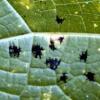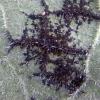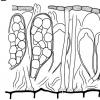
18-12-2025 21:17
Pol DebaenstThe identification took me to Byssonectria deformi

15-12-2025 07:09
 Danny Newman
Danny Newman
indet. Rutstroemiaceae sp. on unk. fallen leavesMc

19-12-2025 10:10
Patrice TANCHAUDBonjour, récolte réalisée en milieu dunaire, a

18-12-2025 17:23
 Bruno Coué
Bruno Coué
Bonjour,je serais heureux d'avoir votre avis sur c

18-12-2025 18:07
Margot en Geert VullingsThese plumes were found on rotten wood.They strong

17-12-2025 18:35
 Michel Hairaud
Michel Hairaud
Bonjour à tous/Hi to everyone I am passing along

15-12-2025 15:48
 Danny Newman
Danny Newman
Melanospora cf. lagenaria on old, rotting, fallen

15-12-2025 15:54
 Johan Boonefaes
Johan Boonefaes
Unknown anamorph found on the ground in coastal sa

15-12-2025 21:11
 Hardware Tony
Hardware Tony
Small clavate hairs, negative croziers and IKI bb
Asterotexis/Schyzothyrium
Esquivel-Rios Eduardo,
23-09-2012 00:12
In 1993 i found a Foliar Disease of "Chayote" Sechium edule, and others Cucurbita spp. cultivated, called "Black Star Spot", and classifed as Schyzothyrium sp. The fungi grows over the leaf cuticule and apparently not penetrates host tissue, as a comensal. The fungi tissue can cover all foliar lamina, causing poor photosintesis al chlorosis of leaf. Recently, Guerrero, . et al (2011) revised this fungi and determinates is Asterotexis cucurbitacearum (Rehm) Von Arx. because found evidences of real parasitism. The two especies are identical, and the difference is the cuticule penetration by haustoria. May be any can help in this ..?
Guerrero et al. (2011) Mycology 2(2):87-90





